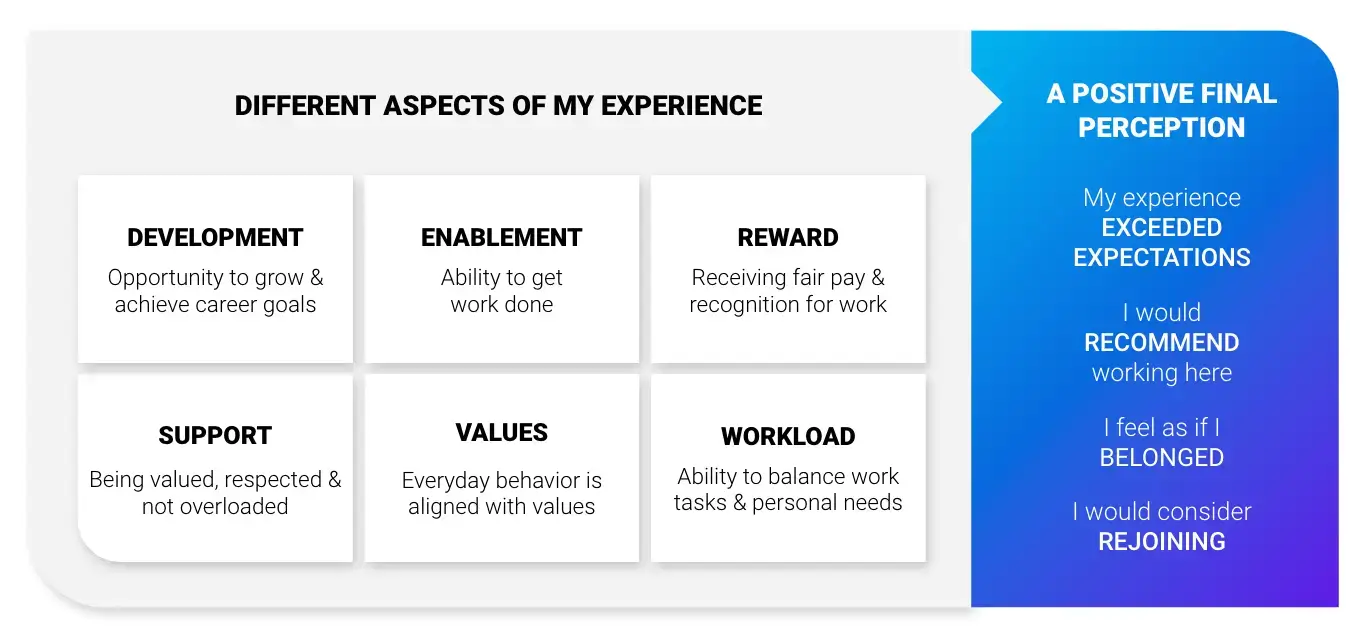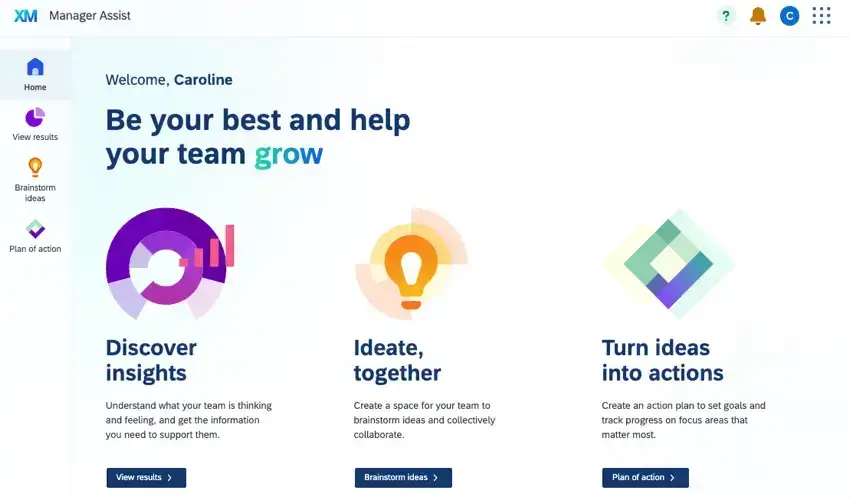What is manager feedback?
Traditionally, it was managers who gave feedback to employees. But with the realisation that gathering and acting on everyone’s feedback improves employee experience, customer experience and brand equity, giving feedback about managers (upward feedback) is an important part of the process.
A manager has expectations of their team members, and it’s only fair that team members have expectations of their manager. Successful teams have open manager-employee communication that flows both ways; being able to give feedback about your manager helps reinforce the things that are going well and highlight those that are not, so they can be improved. And with frequent 360 development surveys, issues can be highlighted and addressed before they become big and intractable.
Watch demo: 360 degree feedback software
Why is manager feedback so important?
When managers don’t know what their reports think of them, their unchecked behaviours and approach may be detrimental to the team, the projects and the business. And because every employee has their own, unique perspective on how their company operates, managers will benefit from these insights.
And in uncertain times – post-pandemic and beyond – managers must help their teams navigate economic challenges, furloughs, redundancies, organisational restructuring, remote working, returning to work, future ways of working… and remain productive. They must offer employees clarity, direction and support, and to do this they need to understand how they can best support them.
Managers have many responsibilities and conflicting goals; getting input from their employees can help them understand where they should prioritise their time and attention in order to maximise the return to their team.
Thus, upward feedback is critical for organisations to survive and thrive in times of uncertainty and change.
When to give manager feedback
1. When things are going well
Giving your manager positive and constructive feedback (they probably rarely receive it) will encourage them to continue with a successful approach. You’ll also come across as honest and helpful, with a valued opinion that’s worth consulting again and again. Positive affirmation also builds up good relationships that form the basis of networking: your manager will remember you even if they move to another job, which can enhance your own career prospects.
2. When things aren’t going so well
Managers can’t fix what they don’t know about, nor can they be everywhere at once. Pointing out what needs improving will highlight areas that could run more efficiently and productively. And sometimes there are managers who you just can’t get on with; an anonymous trackable feedback system will highlight honestly where the issues and conflicts are, which are the first steps to report interpersonal challenges and resolution. The most important thing to remember here is that critical feedback must be constructive feedback.
The benefits of manager feedback
— Qualtrics Chief Workplace Psychologist Dr. Benjamin Granger
Research from Qualtrics found that 43% of managers and 41% of senior leaders feel more pressure to produce results than they did a year ago. In addition to that pressure, in the new world of remote and hybrid work, 43% of managers also say they feel more pressure to be visible to leadership, regardless of their achievements.
It’s important to remember that your manager is an employee of the company too: their performance is being measured, and they will want to improve that performance. It’s all part of their professional development.
Employee engagement, wellbeing, job enablement and employee retention will all be KPIs on a front-line manager’s scorecard, so it’s crucial that they know about, and can solve, issues that may result in team members struggling or even leaving.
On promotion to a people management role, first line managers receive training in systems and processes, but less development on how to be a good people manager: e.g. how to communicate effectively with employees; how to take into account all perspectives; how to recognise good performance, and address underperformance.
It’s also important that managers are made aware of their strengths and areas that need development so that they can learn and grow. When a manager cares about their performance and is receptive to employee feedback, everybody benefits, and there are tangible improvements, such as:
- Higher employee engagement
- Better inclusion and wellbeing as people feel they can be their authentic selves
- Improved employee experience
- More psychological safety
Empowering employees to provide feedback for managers
Although the culture is changing, many people feel that giving upward feedback is tantamount to criticising their boss, even if it is honest feedback. To get over this hesitancy, there are several things you can do to make upward feedback part of the normal cadence of communication:
Acknowledge the discomfort of constructive criticism
Openly welcome constructive feedback and express appreciation of advice, whether it’s about management style, skills or the job in general.
Create a company culture of feedback
Actively seek feedback by asking for it regularly from the team. With 360 feedback, it becomes part of the fabric of the job, and regular 1:1s with team members show management is listening and can help fill in any gaps.
Ask about topics that help transform the team
A tap in the restroom may be leaking, or the coffee in the cafe may not taste great, but these things don’t support professional growth. Instead, focus on:
- Development
- Enablement
- Reward
- Support
- Values
- Workload
It’s also important to ask about the topics we all know to be drivers for why employees leave organizations. By including these topics in employee feedback for managers, you can quickly identify issues and close gaps before they cause employee attrition, disengagement or otherwise.

Use action boards
Teams can add their ideas and vote on those from other people so that the best ideas (not necessarily their own) rise to the top.
Connect 360-degree feedback solutions with other voice of the employee tools
Engagement surveys and other employee listening tools give a line manager an even more rounded view of how they are performing as a people leader.
Allow for anonymous feedback
Employees must have ways to provide feedback — both negative feedback and positive feedback — as well as ideas for actions, anonymously.
Many people find it difficult to share feedback for managers face-to-face — so employees must have the right channels so they are able to give considered, structured feedback. Rather than suggestion boxes, tools like Qualtrics™ 360 Feedback are naturally anonymous, scalable across the entire organisation and, most importantly, enables managers and HR leaders to provide targeted feedback for every single employee — along with actions to take to improve.
Ask for manager feedback examples
Encouraging employees to highlight examples of behaviours or situations that they or other team members have observed and commented upon is helpful feedback. Resolving these can put the entire team back on track.
Cultivate an ownership culture
When everyone feels they have a stake in the business’s success: e.g. taking responsibility to improve things; feeling empowered to make their own decisions; not being afraid to make mistakes, everyone is motivated to keep supplying effective feedback.
Receive feedback with good grace
Understand respondents’ motivations in providing honest feedback; don’t make it personal, and respect differences.
Act on honest employee feedback to close the feedback loop
But only act where it is valid and beneficial to the manager, the team and the company, and is not simply negative feedback for the sake of being negative. Action is the most essential part of receiving feedback – taking action closes the feedback loop, ensuring it’s fully implemented into the process.
The more feedback managers receive, the better they will be able to support their teams, and enhance their own professional development. And this contributes to building a culture of feedback across your organisation.
Just be aware that the way you gather feedback for managers is essential for a positive outcome. It’s not a performance review, it’s all about giving constructive feedback in a timely manner to enhance the working relationship, improve communication skills to create a learning curve for the whole team, business executives and senior managers.
Creating a feedback culture like this where everybody is on the same page nurtures personal development and growth, and is not damaging to an individual.
Constructive feedback examples
“Please may we have more regular huddles to make sure we’re all on the right track with our roles in this project? If we can learn the basics on this project, we’ll be more confident to run the next one with less hand-holding.”
This shows a manager that employees are being proactive with their suggestions and are keen to learn and work independently. There’s clearly a communication gap, a lack of direction, and employees need more briefing and guidance in the form of huddles
“Thank you for acknowledging the work I did preparing the report that you presented to the senior management team. I appreciate that you took the time to highlight my efforts in a potentially high-stress meeting.”
This is an example of how two-way feedback can encourage positive behaviour within a team. The manager realises that by modelling praise and recognition, employees take that behaviour on board and reciprocate.
“Thank you for taking on the task of explaining such a huge amount of data. However, we all got a bit lost in the middle and I noticed some colleagues got bored and were wondering why they were in the meeting. Would it be possible to explain the context of the analysis and who needs to hear it, and maybe turn it into a story that we can all follow? The whole team would get more out of it then.”
The manager will know that you are concerned with the team as a whole and want everyone to be on the same page. They’ve received some praise for their efforts along with constructive feedback.
How can managers ensure their employees’ voices are heard?
Human resources departments now have a new tool on the block – Qualtrics’s Manager Assist. Manager Assist takes the results of engagement pulse surveys, open text responses, HR tickets, public social media comments and sentiments and organisational chats. Using natural language processing and AI, it combs through all that data and recommends what managers need to celebrate with their teams, and what actions they must take to improve.

Our solution measures three things:
- Manager effectiveness
- Strengths and opportunities
- Opportunities to increase team engagement
You’ll also get built-in action planning and collaboration tools, so managers can meet with their teams to collaborate, brainstorm, and develop plans with shared accountability. As the actions on the feedback are taken, managers can share the results and progress with their teams.
You’ll find by giving great manager feedback, your business will enjoy higher levels of team engagement, better employee-manager relationships and improved employee satisfaction with work.
Watch demo: 360 degree feedback software